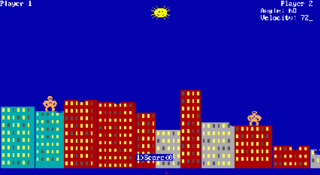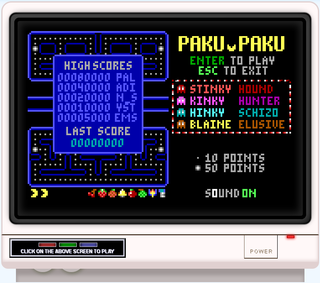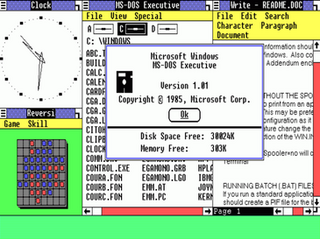
BASIC is a family of general-purpose, high-level programming languages designed for ease of use. The original version was created by John G. Kemeny and Thomas E. Kurtz at Dartmouth College in 1963. They wanted to enable students in non-scientific fields to use computers. At the time, nearly all computers required writing custom software, which only scientists and mathematicians tended to learn.

GW-BASIC is a dialect of the BASIC programming language developed by Microsoft from IBM BASICA. Functionally identical to BASICA, its BASIC interpreter is a fully self-contained executable and does not need the Cassette BASIC ROM found in the original IBM PC. It was bundled with MS-DOS operating systems on IBM PC compatibles by Microsoft.

IBM PC compatible computers are similar to the original IBM PC, XT, and AT, all from computer giant IBM, that are able to use the same software and expansion cards. Such computers were referred to as PC clones, IBM clones or IBM PC clones. The term "IBM PC compatible" is now a historical description only, since IBM no longer sells personal computers after it sold its personal computer division in 2005 to Chinese technology company Lenovo. The designation "PC", as used in much of personal computer history, has not meant "personal computer" generally, but rather an x86 computer capable of running the same software that a contemporary IBM PC could. The term was initially in contrast to the variety of home computer systems available in the early 1980s, such as the Apple II, TRS-80, and Commodore 64. Later, the term was primarily used in contrast to Apple's Macintosh computers.

Microsoft QuickBASIC is an Integrated Development Environment and compiler for the BASIC programming language that was developed by Microsoft. QuickBASIC runs mainly on DOS, though there was also a short-lived version for the classic Mac OS. It is loosely based on GW-BASIC but adds user-defined types, improved programming structures, better graphics and disk support and a compiler in addition to the interpreter. Microsoft marketed QuickBASIC as the introductory level for their BASIC Professional Development System. Microsoft marketed two other similar IDEs for C and Pascal, viz QuickC and QuickPascal.
Microsoft BASIC is the foundation software product of the Microsoft company and evolved into a line of BASIC interpreters and compiler(s) adapted for many different microcomputers. It first appeared in 1975 as Altair BASIC, which was the first version of BASIC published by Microsoft as well as the first high-level programming language available for the Altair 8800 microcomputer.

SmallBASIC is a BASIC programming language dialect with interpreters released as free software under the GNU General Public License version 3 for Microsoft Windows, Linux and Android.

The Tandy 2000 is a personal computer introduced by Radio Shack in September 1983 based on the 8 MHz Intel 80186 microprocessor running MS-DOS. By comparison, the IBM PC XT used the older 4.77 MHz Intel 8088 processor, and the IBM PC/AT would later use the newer 6 MHz Intel 80286. Due to the 16-bit data bus and more efficient instruction decoding of the 80186, the Tandy 2000 ran significantly faster than other PC compatibles, and slightly faster than the PC AT. The Tandy 2000 was the company's first computer built around an Intel x86 series microprocessor; previous models used the Zilog Z80 and Motorola 6809 CPUs.

Nibbles, also known by the source code's file name NIBBLES.BAS, is a variant of the snake video game concept used to demonstrate the QBasic programming language. Nibbles was written in QBasic by Rick Raddatz, who later went on to create small businesses such as Xiosoft and Bizpad.

Gorillas, also known under the source code's file name GORILLA.BAS, is a video game first distributed with MS-DOS 5 and published in 1991 by Microsoft. It is a turn-based artillery game. With allusions to King Kong, the game consists of two gorillas throwing explosive bananas at each other above a city skyline. The players can adjust the angle and velocity of each throw as well as the gravitational pull of the planet.

TopView is the first object-oriented, multitasking, and windowing, personal computer operating environment for PC DOS developed by IBM, announced in August 1984 and shipped in March 1985. TopView provided a text-mode operating environment that allowed users to run more than one application at the same time on a PC. IBM demonstrated an early version of the product to key customers before making it generally available, around the time they shipped their new PC AT computer.
Mallard BASIC is a BASIC interpreter for CP/M produced by Locomotive Software and supplied with the Amstrad PCW range of small business computers, the ZX Spectrum +3 version of CP/M Plus, and the Acorn BBC Micro's Zilog Z80 second processor.

A personal computer game, also known as a computer game or abbreviated PC game, is a video game played on a personal computer (PC). They are defined by the open platform nature of PC systems.
Neil Konzen is a computer programmer who formerly worked for Microsoft as one of its earliest employees. He was the systems programmer of Microsoft's Macintosh programs projects, including Multiplan and Word for the Mac in 1984. He was later tasked with leading the team that created the second version of Windows at Microsoft, after the failure of the original version.
BSAVE and BLOAD are commands in many varieties of the BASIC programming language. BSAVE copies RAM to a binary file, and BLOAD copies the contents of the file to RAM. The term "BSAVE image" could mean any of various raw image formats of video display controllers, or more generally any file containing the raw contents of a section of memory.

Windows 1.0 is the first major release of Microsoft Windows, a family of graphical operating systems for personal computers developed by Microsoft. It was first released to manufacturing in the United States on November 20, 1985, while the European version was released as Windows 1.02 in May 1986.

QBasic is an integrated development environment (IDE) and interpreter for a variety of dialects of BASIC which are based on QuickBASIC. Code entered into the IDE is compiled to an intermediate representation (IR), and this IR is immediately executed on demand within the IDE.
The IBM Personal Computer Basic, commonly shortened to IBM BASIC, is a programming language first released by IBM with the IBM Personal Computer, Model 5150 in 1981. IBM released four different versions of the Microsoft BASIC interpreter, licensed from Microsoft for the PC and PCjr. They are known as Cassette BASIC, Disk BASIC, Advanced BASIC (BASICA), and Cartridge BASIC. Versions of Disk BASIC and Advanced BASIC were included with IBM PC DOS up to PC DOS 4. In addition to the features of an ANSI standard BASIC, the IBM versions offered support for the graphics and sound hardware of the IBM PC line. Source code could be entered with a full-screen editor, and limited facilities were provided for rudimentary program debugging. IBM also released a version of the Microsoft BASIC compiler for the PC concurrently with the release of PC DOS 1.10 in 1982.

A BASIC interpreter is an interpreter that enables users to enter and run programs in the BASIC language and was, for the first part of the microcomputer era, the default application that computers would launch. Users were expected to use the BASIC interpreter to type in programs or to load programs from storage.














